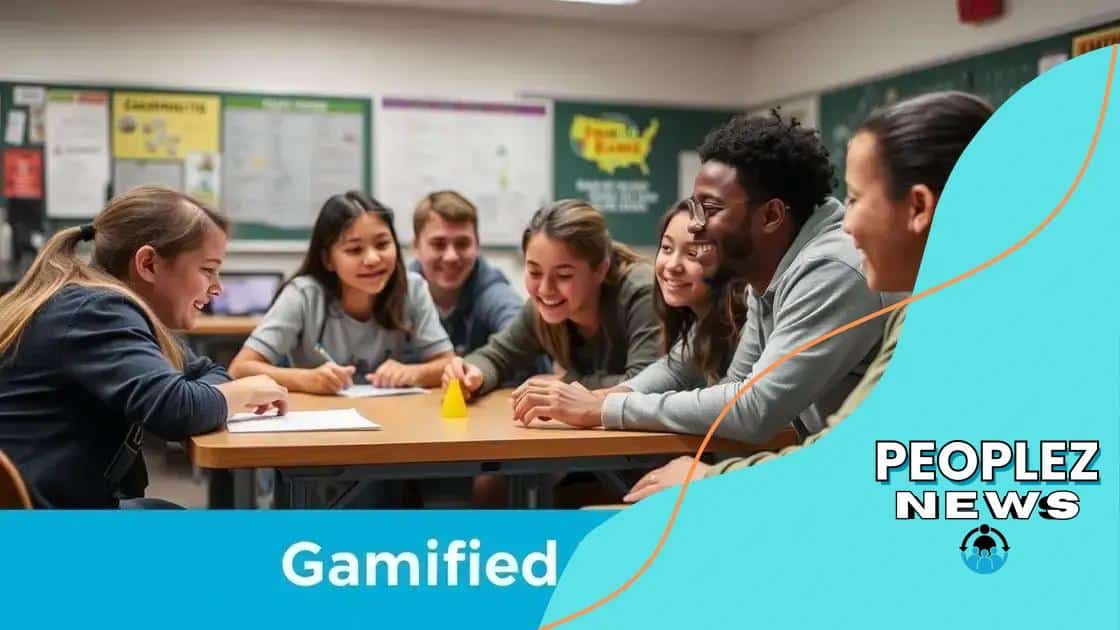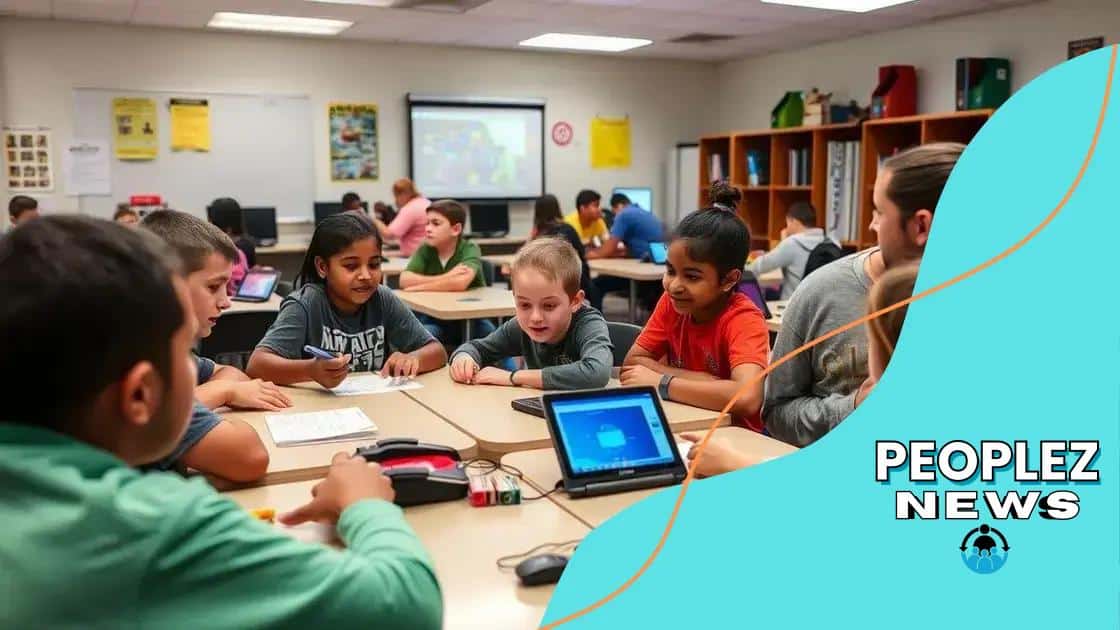Gamification in classrooms to improve engagement

Gamification in classrooms improves engagement by incorporating game elements into learning, enhancing motivation, retention, and collaboration among students through interactive experiences.
Gamification in classrooms is transforming the way teachers connect with students. Have you ever wondered how game mechanics can enhance learning? By incorporating playful elements, educators can create an immersive environment that captivates students’ attention.
Understanding gamification in education
Understanding gamification in education is crucial for modern teaching methods. It refers to the use of game design elements in non-game contexts to inspire students. By incorporating these elements, educators can enhance motivation and make learning more enjoyable.
Game mechanics can include points, badges, and leaderboards, which not only create a sense of achievement but also encourage healthy competition among students. Integrating these fun elements can transform a traditional classroom into an engaging learning environment.
The core elements of gamification
Implementing gamification involves several key components:
- Game mechanics: These are the rules and systems that drive engagement, like levels or challenges.
- Feedback systems: Providing consistent feedback helps students understand their progress and areas for improvement.
- Incentives: Rewards can motivate students to participate actively and achieve learning goals.
Gamification helps in setting clear objectives. By using game-like structures, teachers can clarify expectations and make these objectives more appealing. For instance, students can earn points for completing tasks or mastering concepts, creating a roadmap to success.
Why gamification works
One major reason gamification in education is effective is because it taps into natural human instincts. People are wired to enjoy challenges and rewards. When students see their efforts recognized through badges or scores, their desire to learn increases significantly.
This approach not only fosters a competitive spirit but also aids collaboration among peers. Students often work together on group challenges, enhancing teamwork skills and building social relationships in the process. As students engage more with their peers and content, the overall learning experience becomes rich and memorable.
Gamification can be adapted for various subjects and age groups, ensuring a wide range of applications. From math games that challenge students to solve problems to language arts activities that involve storytelling, the possibilities are endless.
Ultimately, understanding gamification in education is about recognizing its potential to create a positive impact on student learning experiences. By engaging students in a fun and interactive way, teachers can foster a love for learning that lasts a lifetime.
Benefits of gamification for student engagement
Benefits of gamification for student engagement are numerous and impactful. This innovative approach to learning captivates students and encourages active participation. By transforming routine lessons into interactive experiences, gamification creates an exciting environment where students want to learn.
One of the primary advantages is increased motivation. When students have opportunities to earn rewards or compete for top scores, their enthusiasm naturally grows. They feel more driven to complete tasks, leading to improved performance and retention of knowledge.
Enhanced retention through fun
Gamification also enhances information retention by making learning enjoyable. Engaging activities, like quizzes and challenges, help students remember what they learn better than traditional methods.
- Interactive learning: Students are more likely to remember content when interacting with it through games and activities.
- Immediate feedback: Gamification offers instant feedback, helping students learn from mistakes in real-time.
- Increased participation: Fun elements encourage shy students to join in and contribute.
Furthermore, the social aspects of gamification foster collaboration among students. When working in teams, they develop communication skills and strengthen relationships. Through shared challenges, students support each other, making learning a communal experience.
Building a growth mindset
By using game-like mechanics, students develop a growth mindset. They learn that effort leads to success, which encourages resilience. If they do not perform well initially, they are motivated to try again instead of giving up.
Gamification for student engagement also allows for personalized learning experiences. Teachers can tailor challenges to meet individual needs. This flexibility accommodates different learning styles and paces, ensuring all students can succeed.
In summary, the benefits of gamification for student engagement are profound. It motivates students, enhances retention, fosters collaboration, and promotes a growth mindset, leading to a more effective and enjoyable learning experience.
Effective game-based learning techniques

Effective game-based learning techniques are essential for creating an engaging classroom environment. These methods transform traditional learning into interactive experiences that stimulate students’ interests. By incorporating games into lessons, teachers can make understanding difficult concepts much easier.
One key technique is using role-playing games. This allows students to step into characters and experience scenarios that relate to the subject matter. Role-playing fosters empathy and deeper understanding of complex topics. Additionally, it encourages students to think critically and collaboratively.
Incorporating technology
Digital games are another crucial element. Online platforms and educational software offer a wide range of interactive activities suited for various learning styles. These games provide instant feedback, helping students see their progress along the way.
- Adaptive learning: Digital games can adjust to each student’s level, ensuring they face suitable challenges.
- Immediate feedback: Students receive feedback on their performance instantly, allowing for quick corrections and improvements.
- Engagement: Technology keeps students invested in learning through exciting visuals and interactive tasks.
Another effective approach is using team-based challenges. Organizing students into teams for educational games encourages collaboration. When students work together towards common goals, they learn to communicate and solve problems as a group. This also helps build social skills and fosters a sense of community in the classroom.
Gamifying assessments
Assessments can also benefit from game-based techniques. Instead of traditional tests, using game formats such as quizzes or scavenger hunts can reduce anxiety and promote a fun learning atmosphere. For example, a classroom scavenger hunt that involves solving math problems or answering questions can make reviews more dynamic.
Incorporating storytelling in lessons can also enhance engagement. Creating narratives around the subject matter helps students connect emotionally with the content. These stories can revolve around challenges that students must overcome, making learning feel like an adventure.
Effective game-based learning techniques are versatile and can adapt to any subject. By combining these methods, teachers can create a classroom environment that is not only educational but also enjoyable and motivating.
Challenges in implementing gamification
Challenges in implementing gamification can sometimes overshadow its benefits. While gamification can enhance engagement and motivation, educators may face several hurdles when trying to incorporate it into their classrooms. Identifying these challenges is crucial for effective implementation.
One significant issue is lack of resources. Many schools may not have access to the technology or materials needed to create interactive learning experiences. Budget constraints can limit the ability to purchase educational games or software. This can be particularly challenging in underfunded schools, making it difficult to provide a gamified experience.
Balancing game elements and curriculum
Another challenge is balancing game mechanics with the curriculum. Educators must ensure that the use of games aligns with learning objectives. Sometimes, teachers may focus too much on the game aspects, losing sight of the educational content that needs to be taught.
- Alignment: Teachers should carefully assess how each game element supports the learning goals.
- Assessment: Determining how to assess learning outcomes can be tricky with gamified activities.
- Time constraints: Planning and implementing gamification requires time, which can be difficult within a packed curriculum.
Furthermore, not all students respond positively to gamified learning. Some might become overly competitive or distracted by the game aspects, which can hinder their learning. Educators must find ways to manage these situations to ensure a productive atmosphere.
Training and support for teachers
Training is also a vital concern. Teachers may not be familiar with gamification techniques and may need professional development to implement them effectively. Without proper training, they may struggle to integrate gamified elements seamlessly into their lessons.
Challenges in implementing gamification can be mitigated through collaboration among educators. Sharing best practices and successful strategies can help create a supportive network. Additionally, schools can seek assistance from edtech companies that provide resources and training on gamified learning.
Despite these challenges, the potential for gamification to transform learning experiences makes it a valuable approach. By addressing these hurdles, educators can better harness the power of games to engage their students.
Future trends in gamification and education
Future trends in gamification and education show a promising evolution in how we engage students in the learning process. As technology advances, so does our ability to create immersive experiences that can profoundly impact education. Understanding these trends is essential for educators looking to enhance their teaching methods.
One significant trend is the rise of virtual reality (VR) and augmented reality (AR). These technologies provide immersive educational experiences. Students can explore historical sites or conduct science experiments in a safe environment, all while engaging in gamified learning.
Adaptive learning technologies
Another vital development is the use of adaptive learning technologies. These systems customize learning experiences based on each student’s progress and needs. By continually assessing student performance, these technologies provide personalized challenges and rewards, making learning more effective.
- Data analytics: Schools will increasingly use data analytics to track student performance and engagement more closely.
- Gamified assessments: Future assessments may incorporate game elements, making tests more interactive and less stressful.
- Social learning: Enhanced collaborative tools will allow students to engage with peers in gamified environments.
Additionally, we can expect increased integration of artificial intelligence (AI) in educational gamification. AI can help create personalized learning paths and simulate real-world challenges. Students will be able to learn by solving problems similar to those they may face outside the classroom.
Increased focus on soft skills
Future gamification trends also include a stronger emphasis on developing soft skills such as teamwork, communication, and problem-solving. Games designed to promote these skills will become more prevalent in classrooms. As education shifts toward a holistic approach, teaching these skills through engaging activities becomes crucial.
Moreover, the importance of teacher training in gamification practices will grow. Professional development programs will need to focus on equipping educators with the skills to implement these technologies effectively. Teachers will become facilitators who encourage exploration through gamified learning.
As we embrace the future, the potential of gamification and education is vast. With the right tools and strategies, we can transform classroom environments, making learning engaging, interactive, and tailored to individual student needs.
FAQ – Frequently Asked Questions about Gamification in Education
What are the main benefits of gamification in education?
Gamification increases student engagement, motivation, and retention by making learning interactive and enjoyable.
How can technology enhance gamification?
Technologies like virtual reality (VR) and augmented reality (AR) create immersive learning experiences, allowing students to explore and interact in new ways.
What challenges do teachers face when implementing gamification?
Teachers may struggle with limited resources, balancing game elements with curriculum, and needing proper training to use gamification effectively.
How is gamification evolving in education?
Future trends include the integration of AI for personalized learning, a focus on soft skills development, and the use of adaptive learning technologies.





